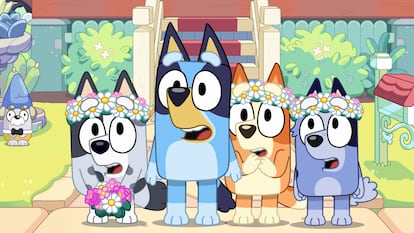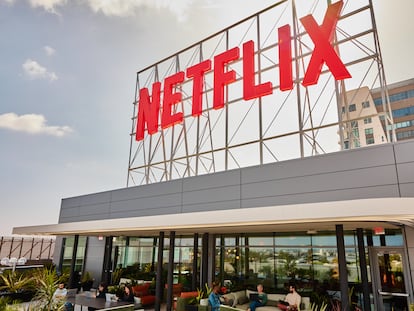‘‘Bluey’ is a Trojan horse’: Inside the latest phenomenon in kids’ animation
The Australian cartoon is ending its third season with a half-hour special. ‘We have a monkish dedication to the show,’ says one of its producers
If you have preschool-aged kids, it’s quite likely that you’ve spent the last few days in anticipation, if not anguish, over the future of a family of animated Australian cattle dogs. That may be true even if you don’t have kids. Such angst would be attributed to Bluey, a record-breaking phenomenon. According to Bloomberg, the show was responsible for 29% of all views (besides those of movies) on Disney+ during the fourth quarter of 2023. Last year, it was the second most-watched series across all U.S. streaming platforms. It’s estimated that the franchise, which includes video games, apps, books, music albums, immersive experiences, theater productions (like that which will soon tour 11 Spanish cities) and all kinds of merchandise, is valued at $2 billion. This Sunday marks the debut of its 28-minute special (a departure from its standard eight-minute episodes), The Sign, with which the series will attempt another of its trademark plot twists that have made followers of both kids and adults. The special’s plot promises a wedding and a possible move — hence the angst.
Bluey kicked off in 2018. Its creator Joe Brumm had worked on children’s animated series for a decade in the United Kingdom, and upon returning home to Australia, came up with an idea for a kind of Australian Peppa Pig. The father of two, he decided to base the project on an idealized version of his own family, from which were born the puppy Bluey, her younger sister Bingo and their parents, Bandit and Chilli, four anthropomorphic dogs who, throughout their adventures, extol the enormous value of family and play.
The force behind Bluey is Australia’s Ludo Studio, which was co-founded by Charlie Aspinwall and Daley Pearson and specifically created to launch the animated series. As Pearson tells it in a videocall interview from Brisbane, where the company is based, between 50 and 60 people work to develop the series, which has become a source of national pride because of the global visibility it has brought to Australia. “It was over half the studio’s first job out of uni. When we started Bluey, there was a bit of like, not only can we make a good show, but can we make an episode? Like, can we actually produce something with this new studio? That was a really nerve-wracking time,” Pearson recalled last Wednesday. To put out the more than 150 episodes that comprise the series’ three seasons, the team split up into four groups that worked in parallel. The Sign marks the first time that the entire studio has worked together on the same episode.

Since its premiere, the series has become a hit on Australian broadcast channel ABC, and was soon added to BBC Studios programming. Later on, it entered into the Disney equation, and its presence on Disney Channel and Disney+ has brought the series to more than 60 countries, making it the international smash that it is today. “It’s about families. In spite of the accents, in spite of the location, in spite of it being very Australian — because it is very Australian — at the heart of it, it’s about a family going through their lives, day to day. Everyone knows what It’s like to be part of a family, it’s something you can’t escape, you’re born into it,” reflects Pearson.
In Bluey’s brief episodes, the viewer encounters a little bit of everything. Perhaps this is what has hooked everyone from the preschool set to their parents, and even adults without any kids at hand. An example can be found in the latest episode: “Why do stories always have happy endings?” asks Bluey in class. “Well, I guess ‘cause life will give us enough sad ones,” answers her teacher. Among the more or less classic escapades, from time to time appear almost psychedelic episodes about dreams, reflections on depression, infertility, pressure on parents and even a trial about a possible situation involving flatulence. “It started being very simple stories about real things that a family goes through. And then as it grew, as the audience grew, I think we all wanted to start taking a few more risks. It felt like the audience would go with us somewhere that the children’s TV show hasn’t gone. Bluey was always a Trojan horse. It was disguised as a children’s show, but it was really a show for parents and kids,” says Pearson.
"Bigger on the inside" you say? ... @bbcdoctorwho 🏠 👀 #Bluey #Ghostbasket pic.twitter.com/91KfUs1s1i
— Official Bluey TV (@OfficialBlueyTV) April 8, 2024
So were born the more “experimental” episodes, as the producer describes them. Among them, The Sign, whose extra-long duration sets it apart from the series’ standard offerings. “Very, very early on, we told a little promise to ourselves that we would love to make three seasons and a movie. It seemed like something just unimaginable,” says Pearson. When the announcement went out that the third season would end with a special, it was met with questions: could this mean that the series was approaching its finale? “Oh, there’s definitely more Bluey,” clarifies the producer, clearing up any doubts.
How, with its pastel colors and 2D animation, does Bluey stand out among the rest of animated series? For Pearson, the key is in the people who make it. As luck would have it, Brumm, in addition to Aspinwall and David McCormack, who voices the series’ father, Bandit, are fathers of two daughters. “The makers of the show were living the show. It’s an author’s show. It’s not made up. It’s full of very, very real stuff,” he says. Nor does he hide the fact that there is some idealism behind its representation of parenthood, especially in the figure of the father, who is his daughters’ constant playmate. “You’re only seeing seven minutes of their day. That’s the best seven minutes,” laughs Pearson why he is asked about this idealized vision of fatherhood. “Bandit and Chilli, they were always written as aspirational characters. No one’s like them. That’s the best of us, but it’s a dream. In The Sign, they do go through the ups and downs.”
In the opinion of the animation studio’s co-founder, international success has not changed Bluey. “It’s sort of increased our awareness of the responsibility to make the best stories we can for people around the world. Really long days … I think the biggest part is that we have that monkish dedication to the show.” He tells a story: “I remember the first review I saw of it was in The New York Times. It said, ‘This show is set on a tropical island,’ as if Australia is just a fantasy place. They didn’t see that Brisbane, Australia existed,” he laughs.
Sign up for our weekly newsletter to get more English-language news coverage from EL PAÍS USA Edition
Tu suscripción se está usando en otro dispositivo
¿Quieres añadir otro usuario a tu suscripción?
Si continúas leyendo en este dispositivo, no se podrá leer en el otro.
FlechaTu suscripción se está usando en otro dispositivo y solo puedes acceder a EL PAÍS desde un dispositivo a la vez.
Si quieres compartir tu cuenta, cambia tu suscripción a la modalidad Premium, así podrás añadir otro usuario. Cada uno accederá con su propia cuenta de email, lo que os permitirá personalizar vuestra experiencia en EL PAÍS.
¿Tienes una suscripción de empresa? Accede aquí para contratar más cuentas.
En el caso de no saber quién está usando tu cuenta, te recomendamos cambiar tu contraseña aquí.
Si decides continuar compartiendo tu cuenta, este mensaje se mostrará en tu dispositivo y en el de la otra persona que está usando tu cuenta de forma indefinida, afectando a tu experiencia de lectura. Puedes consultar aquí los términos y condiciones de la suscripción digital.
More information
Archived In
Últimas noticias
Most viewed
- Reinhard Genzel, Nobel laureate in physics: ‘One-minute videos will never give you the truth’
- Oona Chaplin: ‘I told James Cameron that I was living in a treehouse and starting a permaculture project with a friend’
- Pablo Escobar’s hippos: A serious environmental problem, 40 years on
- Why we lost the habit of sleeping in two segments and how that changed our sense of time
- Chevy Chase, the beloved comedian who was a monster off camera: ‘Not everyone hated him, just the people who’ve worked with him’












































